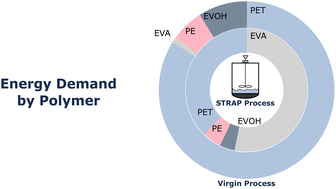Quantifying the environmental benefits of a solvent-based separation process for multilayer plastic films†
Abstract
Food packaging often appears in the form of multilayer (ML) plastic films, which leverage the functional properties of different polymers to achieve specific food protection goals (e.g., oxygen, water, and temperature barriers). These properties are essential to enable long shelf lives, reduce refrigeration usage, mitigate food waste, and increase food accessibility. However, ML film production processes generate large amounts of plastic waste that cannot be mechanically recycled. Recently, we have proposed a process, called solvent-targeted recovery and precipitation (STRAP), that enables the separation and recycling of the constituent polymers of ML films. This technology uses a series of solvent washes that selectively dissolve and precipitate target polymers. Quantifying the environmental benefits of STRAP over virgin resin production is essential for the commercial deployment of this technology. This work uses life cycle assessment (LCA) methods to evaluate these impacts in terms of carbon footprint, energy use, water use, and toxicity. We analyze three STRAP process variants that use antisolvent and temperature-driven precipitation to treat different ML films. Our analysis reveals that the STRAP-A and STRAP-B process variants can provide environmental benefits over virgin film production. Furthermore, it gives valuable insight into the critical components of ML films (specific polymers) and of the STRAP processes (equipment) that are responsible for the highest impacts. Ultimately, we believe that the proposed analysis framework can lead to the design of more environmentally-friendly ML films and recycling processes.



 Please wait while we load your content...
Please wait while we load your content...